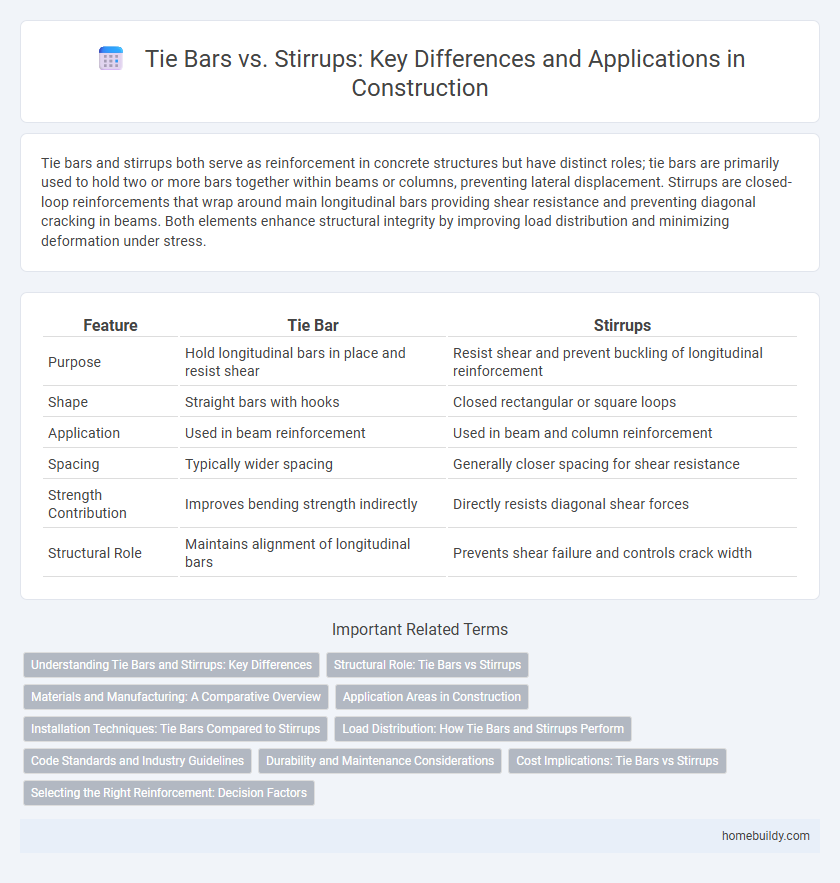Tie bars and stirrups both serve as reinforcement in concrete structures but have distinct roles; tie bars are primarily used to hold two or more bars together within beams or columns, preventing lateral displacement. Stirrups are closed-loop reinforcements that wrap around main longitudinal bars providing shear resistance and preventing diagonal cracking in beams. Both elements enhance structural integrity by improving load distribution and minimizing deformation under stress.
Table of Comparison
| Feature | Tie Bar | Stirrups |
|---|---|---|
| Purpose | Hold longitudinal bars in place and resist shear | Resist shear and prevent buckling of longitudinal reinforcement |
| Shape | Straight bars with hooks | Closed rectangular or square loops |
| Application | Used in beam reinforcement | Used in beam and column reinforcement |
| Spacing | Typically wider spacing | Generally closer spacing for shear resistance |
| Strength Contribution | Improves bending strength indirectly | Directly resists diagonal shear forces |
| Structural Role | Maintains alignment of longitudinal bars | Prevents shear failure and controls crack width |
Understanding Tie Bars and Stirrups: Key Differences
Tie bars are horizontal reinforcement bars used to hold main reinforcement bars together in reinforced concrete structures, preventing lateral displacement under load. Stirrups are closed-loop reinforcement elements placed around longitudinal bars in beams and columns to resist shear forces and prevent buckling. Unlike stirrups that primarily provide shear strength, tie bars mainly ensure the stability and alignment of tension reinforcement during concrete placement.
Structural Role: Tie Bars vs Stirrups
Tie bars serve a crucial structural role by providing tensile reinforcement in concrete beams, helping to resist shear forces and prevent diagonal cracking. Stirrups, on the other hand, primarily function as transverse reinforcement that encircle the longitudinal bars to hold them in place and enhance shear strength by confining the concrete. Both components work together to improve the overall ductility and load-carrying capacity of the reinforced concrete structure.
Materials and Manufacturing: A Comparative Overview
Tie bars are commonly made from high-strength steel with a smooth or deformed surface, ensuring effective load transfer, while stirrups typically use cold-rolled steel with a deformed profile for enhanced bonding in concrete. Manufacturing tie bars involves precise straightening and cutting processes to achieve uniform length and tensile properties, whereas stirrups require bending machines to create closed-loop shapes that reinforce the concrete structure. Both components utilize corrosion-resistant treatments such as epoxy coating or galvanization to enhance durability in construction applications.
Application Areas in Construction
Tie bars are primarily used in beam and column reinforcement to control cracks and enhance structural integrity, especially in high-stress zones. Stirrups are commonly applied in shear reinforcement within beams to resist diagonal tension forces and improve load-bearing capacity. In construction, tie bars target longitudinal reinforcement, while stirrups focus on transverse reinforcement, making them complementary in ensuring overall structural stability.
Installation Techniques: Tie Bars Compared to Stirrups
Tie bars are installed longitudinally along the beam or slab to resist tensile forces, requiring precise alignment and secure anchorage to the main reinforcement. Stirrups, positioned transversely around longitudinal bars, demand consistent spacing and firm ties to control shear and hold the main bars in place. The installation of tie bars allows for enhanced load distribution and crack control, while stirrups provide critical shear resistance through their closed-loop arrangement.
Load Distribution: How Tie Bars and Stirrups Perform
Tie bars distribute tensile forces primarily along the longitudinal axis of concrete beams, enhancing resistance to cracking under bending stresses. Stirrups, arranged transversely, effectively resist shear forces and prevent diagonal cracking by confining the concrete core. Together, tie bars and stirrups optimize load distribution by addressing distinct stress components, ensuring structural integrity and durability.
Code Standards and Industry Guidelines
Tie bars and stirrups serve distinct roles in reinforced concrete structures, with tie bars primarily resisting tensile forces and stirrups designed to handle shear stresses. Code standards such as ACI 318 and Eurocode 2 specify the placement, spacing, and minimum reinforcement requirements for tie bars and stirrups to ensure structural integrity and compliance with safety regulations. Industry guidelines emphasize proper anchorage and dimensioning, mandating that tie bars must meet specified yield strength and ductility criteria to perform effectively under load conditions.
Durability and Maintenance Considerations
Tie bars offer greater durability compared to stirrups due to their continuous steel reinforcement, which reduces the risk of corrosion and structural fatigue. Maintenance of tie bars is typically less intensive since their design minimizes exposure to environmental elements and stress concentrations. In contrast, stirrups may require more frequent inspections and repairs due to potential shear failure points and corrosion vulnerabilities.
Cost Implications: Tie Bars vs Stirrups
Tie bars generally offer lower material and labor costs compared to stirrups due to their simpler design and easier installation process. Stirrups require more steel and precise bending, increasing both material expenses and labor time. Choosing tie bars can significantly reduce overall reinforcement costs in structural elements without compromising stability in certain applications.
Selecting the Right Reinforcement: Decision Factors
Selecting the right reinforcement involves evaluating tie bars and stirrups based on load distribution, structural support, and tension resistance. Tie bars effectively prevent beam cracking by holding main reinforcement bars in place, while stirrups provide shear strength and confine concrete within beams or columns. Factors such as load type, structural design, and construction requirements guide engineers to optimize reinforcement choices for durability and safety.
Tie bar vs Stirrups Infographic

 homebuildy.com
homebuildy.com